By Linda Gabris
I take a lot of pleasure indulging in cuisines from around the world. One country that holds a special place in my heart is Ireland because my grandmother had Irish roots. Some of the traditional country dishes like “Colcannon” and “Boxty” pancakes that I grew up with and loved as a kid are still my favorite comfort foods today. I enjoy recreating them in my own kitchen.
I learned how to make many of these delicious dishes from the heirloom recipes jotted down in handwriting on slips of yellowed papers stowed away in Grandma’s old recipe file box. It is one of the most prized possessions in my kitchen.
One of the things I love about Irish cookery is that the ingredients called for in most recipes are common staples found in larders, pantries, and root cellars of almost any country cook. I take comfort in knowing that I typically do not have to make a special trip to the grocery store to prepare a hearty Irish meal. When there are potatoes (which is the mainstay of an Irish diet) in the cellar, I know I have the number one fixing for some of the country’s heartiest signature dishes.
Grandma held potatoes in the highest regards, devoting the largest patch in her backyard garden to potatoes and never wasting any precious “purdies” as she fondly called them. According to Grandpa and Grandma, nothing deserves more ground space in a garden than potatoes because, as Grandma would say, “when you have potatoes, you’ll never go hungry…”
In earlier times, pork and mutton were the most commonly eaten meats in Ireland as beef was typically reserved for royalty, with the majority of the country’s cattle landing on the tables of English noblemen. But in the 1660s, the “Cattle Acts” came into effect which prohibited the export of cattle to England and in turn, drove the prices in Ireland down and made beef more readily available and affordable for everyday folks.
Even though salting down meat as a means of preservation was practiced long before the Cattle Acts, it was around about this time that the country’s surplus supply of beef was put up for safe-keeping by brining or “corning” as it became known, thus the term “corned beef” came into use. Surprisingly, corned beef has nothing to do with corn! It refers to the corn-kernel-sized rock salt that was used to preserve the meat.
Here in North America, the mere mention of corned beef is almost always associated with St. Patrick’s Day celebrations where corned beef and cabbage is a traditional feast.
Every fall my grandparents would barter homegrown pork for an equal weight of beef from the rancher across the valley. Grandma would set about making a mouth-watering batch of corned beef from an old family recipe which I have adapted and whittled down in size. You’ll find my recipe (along with Grandma’s old handwritten one) as well as some of my other favorite Irish dishes below.
Give them a try the next time you have a craving to sample some of the world’s most delightful comfort foods that are guaranteed to please the palate as much as the pocketbook.
Irish “working man’s” breakfast:
No doubt about it, this is called a “working man’s” breakfast because it is so rich and filling — guaranteed to keep you “stepping high and mighty over the fields of clover.” Serve with sausages, eggs, or both. Serves 4
- 2 cups dried yellow split peas, cooked tender (To cook split peas, wash in cold running water, put in a saucepan, add a pinch of salt, cover with water and simmer until peas are tender. Drain, reserving cooking liquid for another use, if you wish.)
- Fresh pork sausages (1 or 2 per person depending on size and appetite)
- 3 cups water
- Pinch of salt
- 1 cup steel cut oats
- 4 eggs
- 2 Tbsp. fat (butter, lard, oil)
- 1 minced onion
- Black pepper
Fry sausages and hold hot. Bring lightly-salted water to a boil, add oats and cook about 12 to 15 minutes or until thick. Meantime, poach the eggs. While eggs are cooking, heat the fat in a small skillet and fry the onion until golden. Reheat the peas. To assemble the dish, put a ladle of porridge on one side of the bowl and top it with a spoon of the fried onions. Put a ladle of peas on the other side of the bowl and add a poached egg to the plate along with the sausage (or sausages). Sprinkle it all with black pepper upon serving.
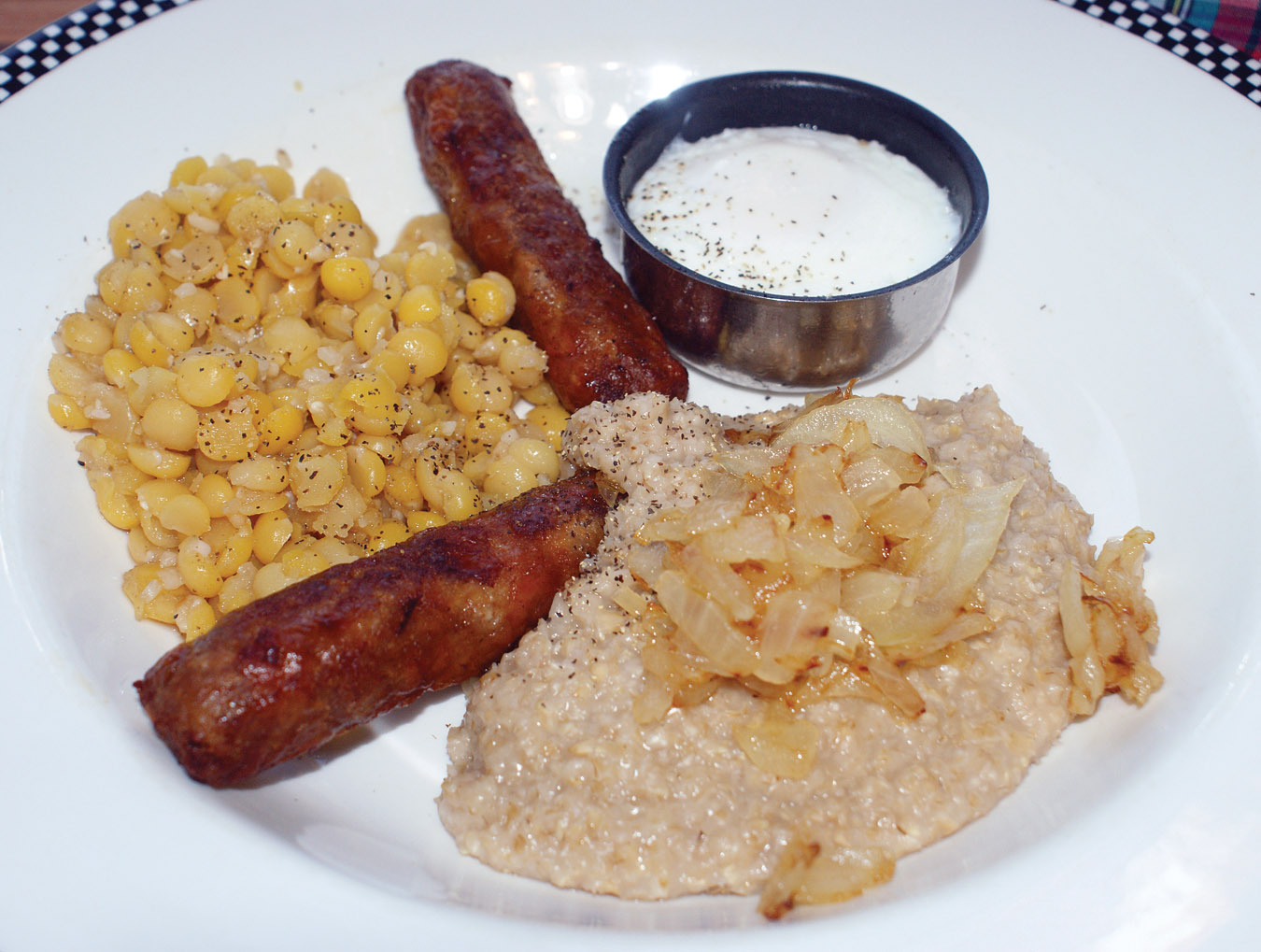
Irish working man’s breakfast — cooked oats, split peas, sausages, poached egg, and fried onions
Grandma’s “cure-all” cabbage soup:
Grandma claimed that this old family recipe would “cure anything that ails you” and during these stressful times, I find this soup really is a number one comfort food that soothes the soul and calms the nerves. Makes a tureen full and is as good, if not better, the second time around when the cabbage has had time to “mature in the pot.”
- 4 Tbsp. fat (like Grandma, pork lard or drippings is my pick, but butter or oil can be used)
- 1 large chopped onion
- 5 cloves minced garlic
- 1 small head (or ½ large head) chopped cabbage
- 2 quarts of chicken stock
- 1 quart stewed chopped tomatoes (I use homemade which contains peppers and celery, so if you are using plain tomatoes, you may wish to add some minced peppers and diced celery to the pot.)
- Salt and pepper to taste
- Butter
Melt fat in a soup pot. Sauté the onion and garlic until soft. Add the cabbage, put the lid on the pot and cook over low heat for about 5 minutes, “sweating the cabbage,” as Grandma would say. Stir in the stock and tomatoes. Bring to a boil, reduce heat, and simmer for 25 minutes. Season the soup with salt and pepper and dot generously with butter upon serving.
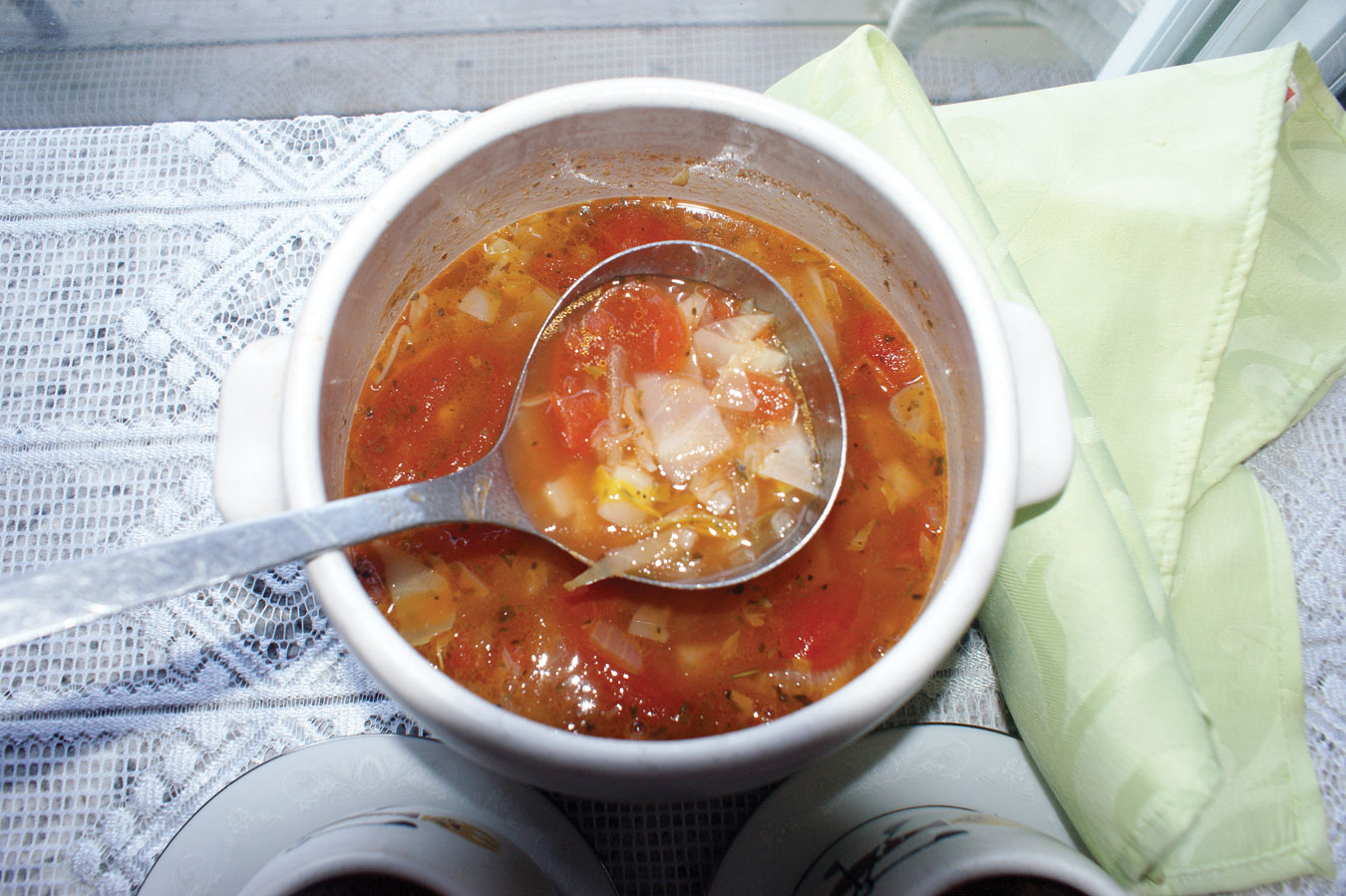
Authentic Irish stew:
Grandma vouched that there should only be four ingredients in a “real” Irish stew. Below is her recipe which is very plain and simple, yet delightfully good. To serve this stew the authentic “Irish way,” it should be ladled onto a heated platter and surrounded by whole boiled potatoes (1 or 2 per serving) which are dotted with butter and seasoned with salt and pepper. No measures, really, because, as Grandma has it written, “just use how much meat you have and how many potatoes you need.”
- Stewing mutton
- Potatoes
- Onions
- Salt and pepper
Cut up a pound or two of stewing mutton into chunks. Put the meat into a pot with barely enough water to cover. Bring to a boil and skim the scum. Add about 3 or 4 sliced potatoes and a couple sliced onions. Simmer covered until the meat is tender and stew is very thick (which will happen when the potatoes turn mushy), about 2 to 3 hours. Grandma cooked this stew very slowly on the back of the woodstove. You can use a slow cooker if you wish. Do not add more water during cooking. When thick to liking, season with salt and pepper.
Colcannon:
Some folks rank colcannon (a dish of boiled potatoes and cabbage) as the national dish of Ireland. I think it second only to Irish stew! This is another recipe that does not call for exact measures. In Grandma’s words, the recipe serves “as much as you make.”
- Boiled mashed potatoes
- Boiled chopped cabbage
- Salt and pepper
- Butter
- Grated cheese (optional)
You simply take equal amounts of hot boiled mashed potatoes and hot boiled drained chopped cabbage and mix them together in a bowl. Season generously with salt and pepper and stir in enough butter or margarine to suit your taste (about 2 tablespoons per cup of vegetables). Serve hot.
For a colcannon casserole, turn the mixture into a buttered baking dish, top with grated cheddar cheese and bake in a 375° F oven until the cheese is melted and bubbling. A little tip: If some of your family likes cheese on top of their colcannon and others don’t, you can prepare it in individual dishes so everyone is happy!
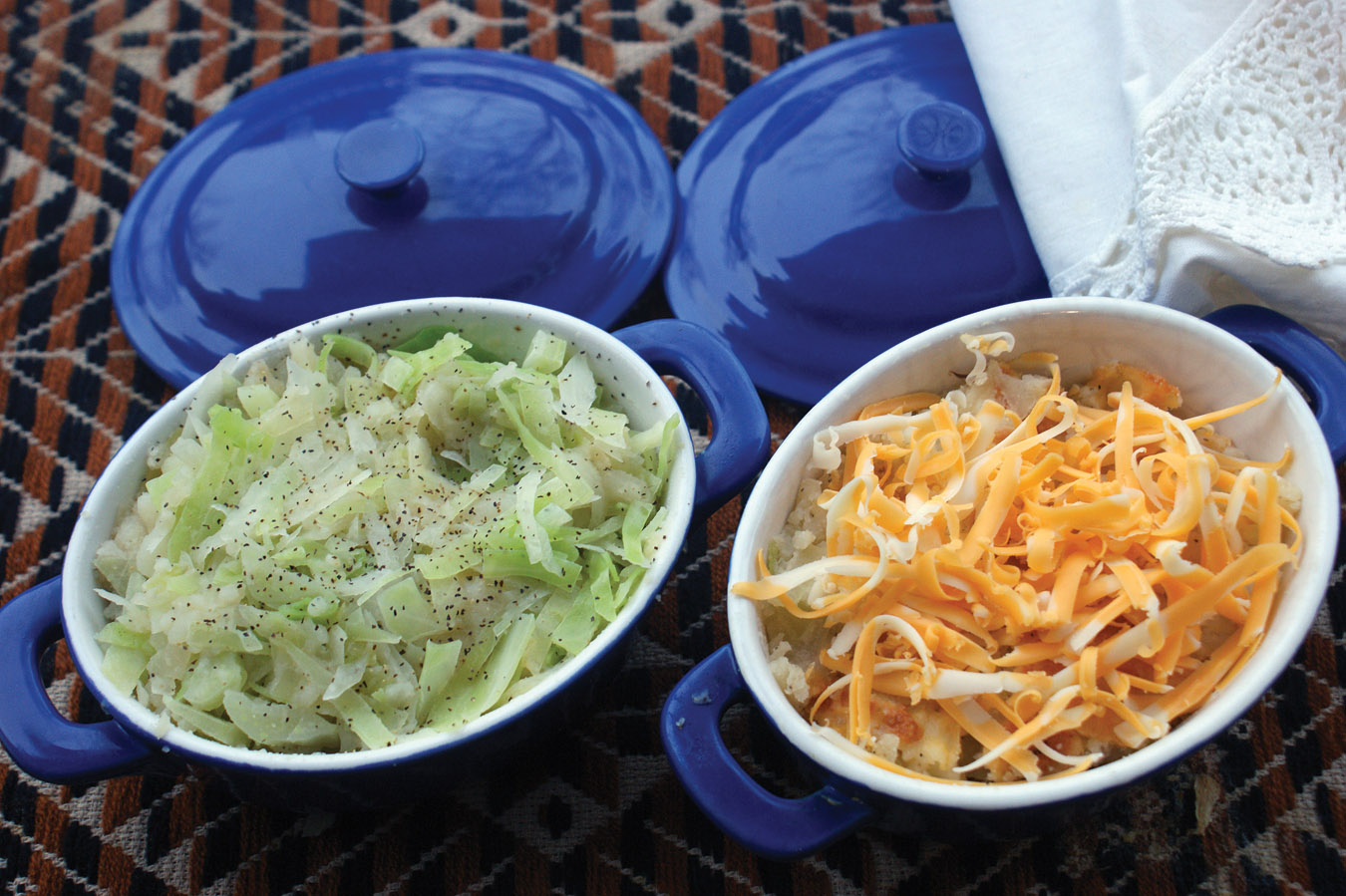
Colcannon, a dish of potatoes and cabbage, can be served in individual dishes. Here one has cheese topping the other does not.
Boxty pancakes:
In Ireland these pancakes are often referred to as “poorhouse bread.” Boxty pancakes are sort of a cross between a potato pancake and hash browns and are made from a mix of mashed cooked potatoes and grated raw potatoes. They are delicious and can be served at any meal. Try them with ketchup or sour cream.
- 2 pounds (4 to 6 large potatoes)
- ¼ cup light cream
- 1 large egg
- ½ cup milk
- ½ cup flour, seasoned with salt and pepper
- Fat for frying (lard or vegetable oil)
Scrape or peel the potatoes. Chop half of the potatoes and boil until fork tender. Drain, add the cream and mash. Set aside. Grate the remaining raw potatoes, place in a strainer, force out excess liquid, and combine with the mashed potatoes. Whisk the egg and milk and fold into the potato mixture alternatively with the flour. Drop by ¼ cupfuls into hot fat in a skillet and fry until bottoms are golden, about 5 minutes. Flip and fry until the other side is also golden brown. Drain on absorbent paper before serving.
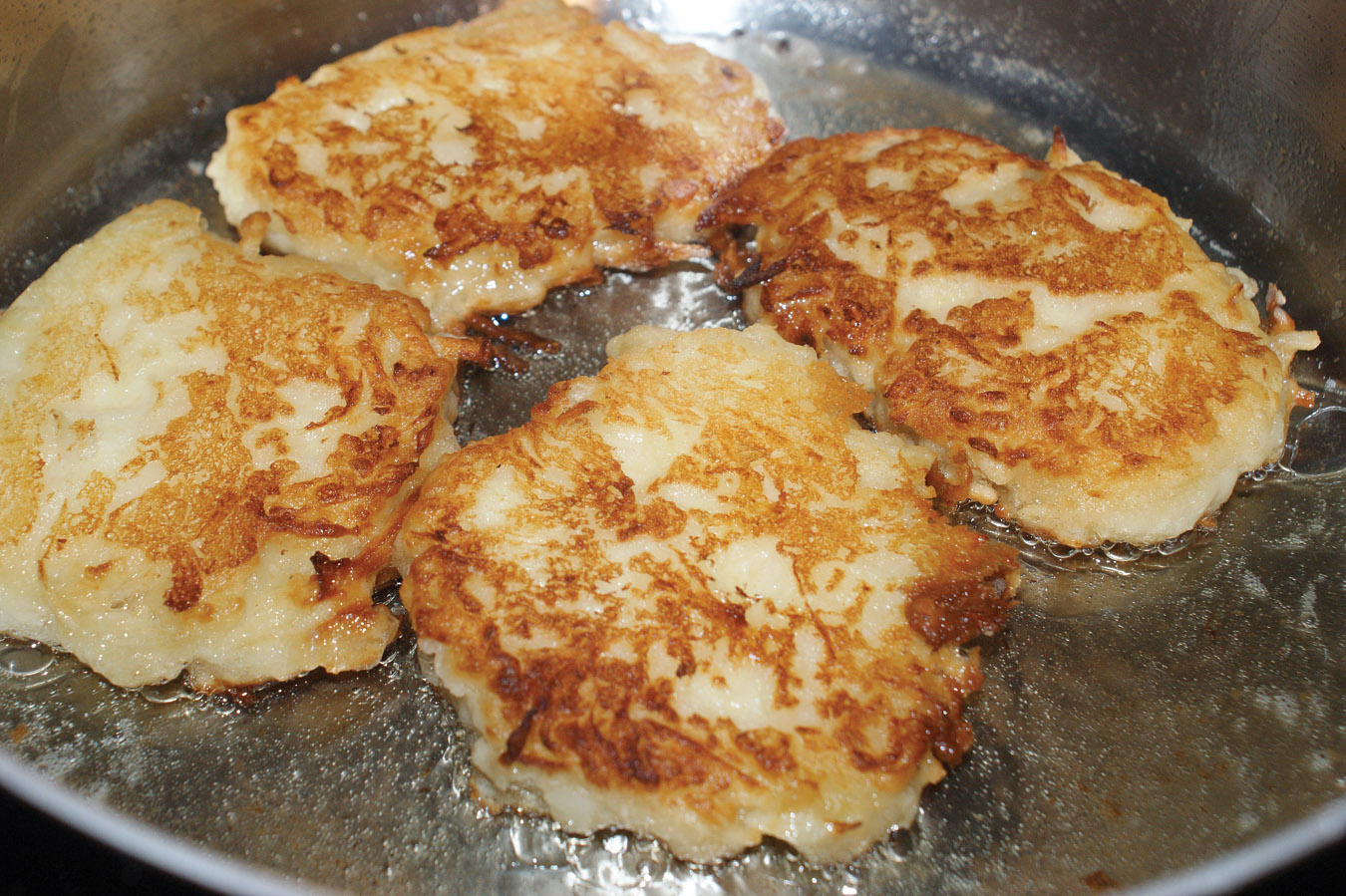
Flip and fry until the boxty pancakes are golden on both sides. Serve with fried eggs for a great breakfast.
Thump (potatoes and green onions):
This ancient dish is also known as “stelk.” Grandma had a huge chive patch by the kitchen stoop, so she always used minced chives in her thump. Both chives and green onions are delicious and really give mashed potatoes a delightful lift. Like Grandpa, I enjoy thump with a fried egg which makes a satisfying breakfast. Thump is also a delicious side dish for roast meats. Makes 4 to 6 servings.
- 1 cup light cream
- 1 cup chopped green onions (or minced chives)
- 4 Tbsp. butter
- Salt and pepper to taste
- 6 to 8 medium to large-sized hot boiled potatoes
Bring the cream to a boil and simmer the chives or onions until tender, 2 to 3 minutes. Stir in the butter and season with salt and pepper. Add the hot boiled potatoes to the pot. Using a hand held masher, mash potatoes until smooth and creamy, adding a little more hot cream if needed to achieve desired consistency. I like mine nice and creamy. Sprinkle with black pepper upon serving.
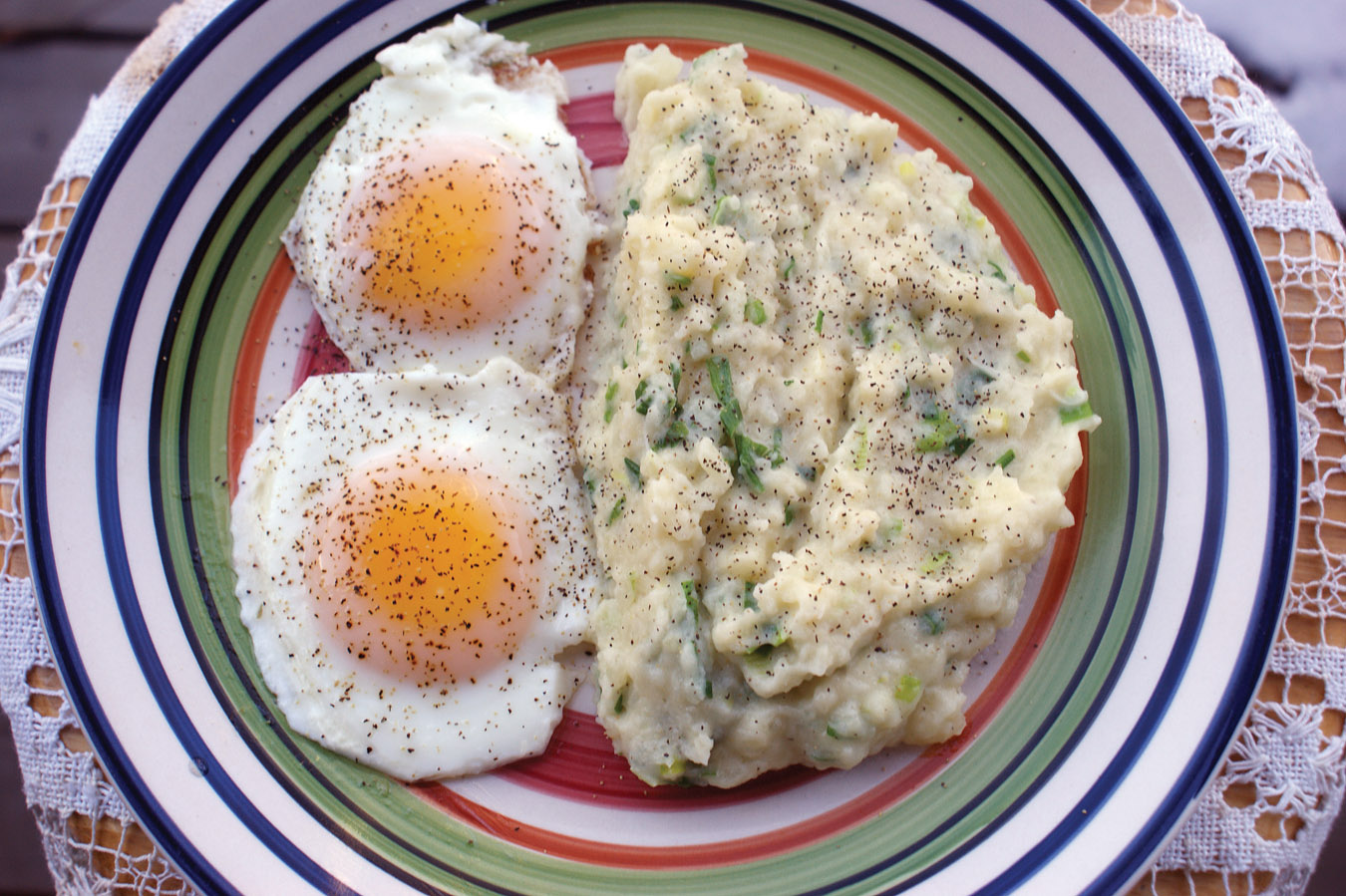
Serving thump for breakfast with eggs is a hearty way to start the day.
Great Grandma’s Irish soda bread:
From the file box comes this wonderful recipe for a soda bread which makes a perfect loaf every time. The buttermilk pairs up with the baking soda and powder to produce a lovely, moist loaf with a delicious golden crust. Serve this as the supper bread of the day — it goes great with soups and stews — or with butter and jam for breakfast fare. Makes a 9 to 10 inch loaf.
- 4 cups all-purpose flour
- ¼ cup white sugar
- 1½ tsp. baking soda
- 1 Tbsp. baking powder
- ½ tsp. salt
- 3/4 cup softened butter, divided
- 1 egg
- 11/4 cup buttermilk, divided
In a bowl, combine flour, sugar, baking soda, baking powder, and salt. Using your fingers, work in ½ cup of butter until crumbly. Beat egg into 1 cup of buttermilk and stir into the dry ingredients. Form dough into a ball, turn out on a floured surface and knead until smooth. Grease a baking sheet, form dough into a round loaf shape and place on the sheet. Using a sharp knife, cut an “X” in the center of the top of the loaf. Melt remaining butter and mix with remaining buttermilk to use as a glaze.
Brush the loaf with the glaze and bake in a 375° F oven for 50 to 60 minutes, or until a toothpick inserted into the center comes out clean, brushing with the remaining glaze until it is used up.
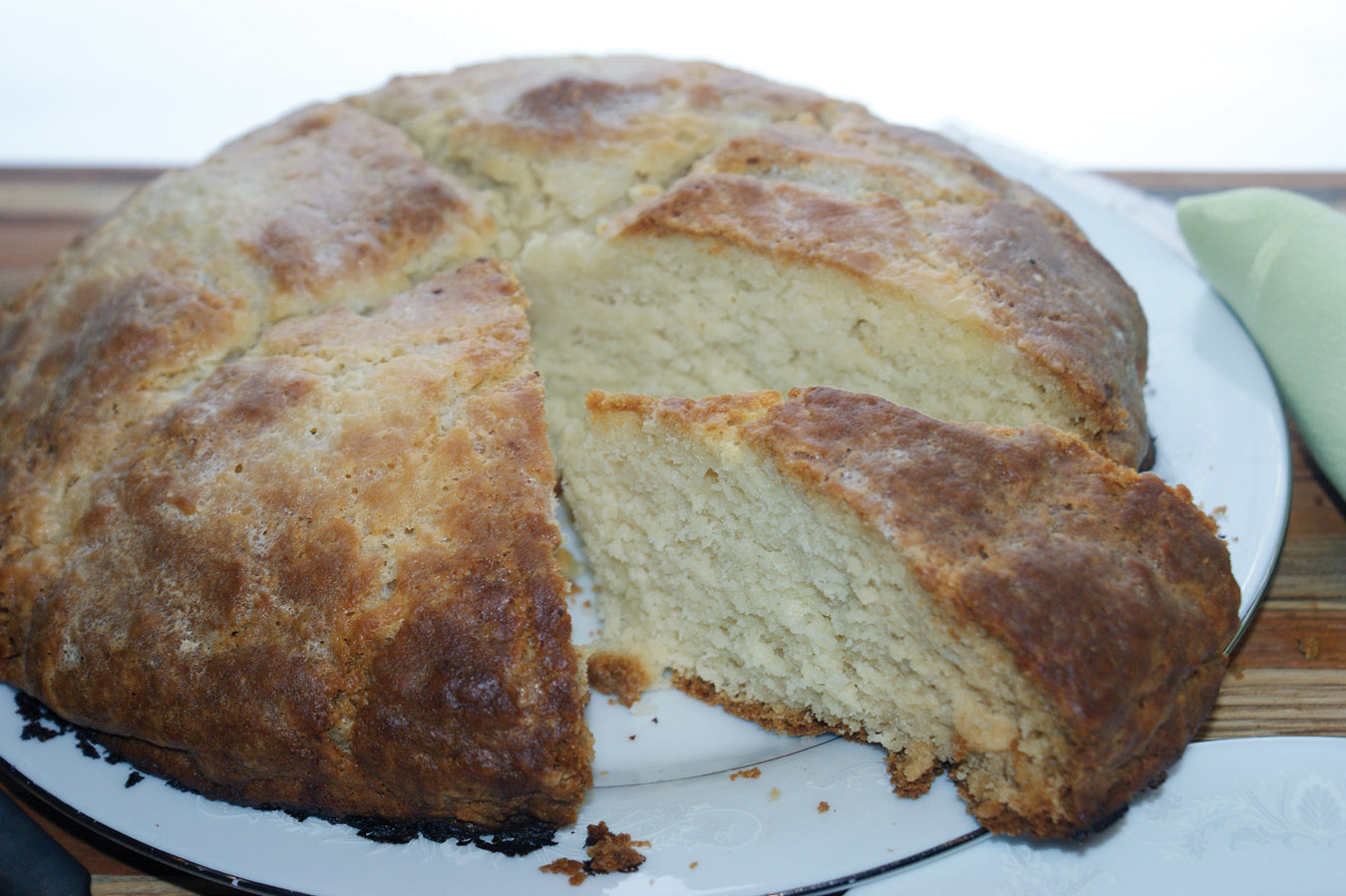
Irish soda bread
Barmbrack:
… a fortune-telling cake
Barmbrack (from the Irish word Breac, meaning “speckled” cake (or bread as it is sometimes referred to) is usually eaten on holidays such as Halloween and birthdays. When I was a kid, Grandma practiced the old custom of wrapping “tokens’’ in parchment paper and tucking them into the cake batter before baking. These items symbolized what kind of “good” or “bad” luck was about to befall you and revealed other secrets (according to whatever the baker hid in the batter).
For instance, if you found a coin in your piece of cake it meant that wealth was about to come your way. If you discovered a ring, Grandma would wink, you’d have a happy marriage. A matchstick warned that you had to get more firewood for the winter and an uncooked bean or pea prompted you to take better care of your garden. A button meant that a new article of clothing was coming your way. I must admit, it was fun as heck finding a token in the cake — with my favorite item being a shiny coin that was a treat almost as good as the cake itself. Of course, Grandma would always point out that the fortunes were only told in good fun, so hunt down charms of your choosing.
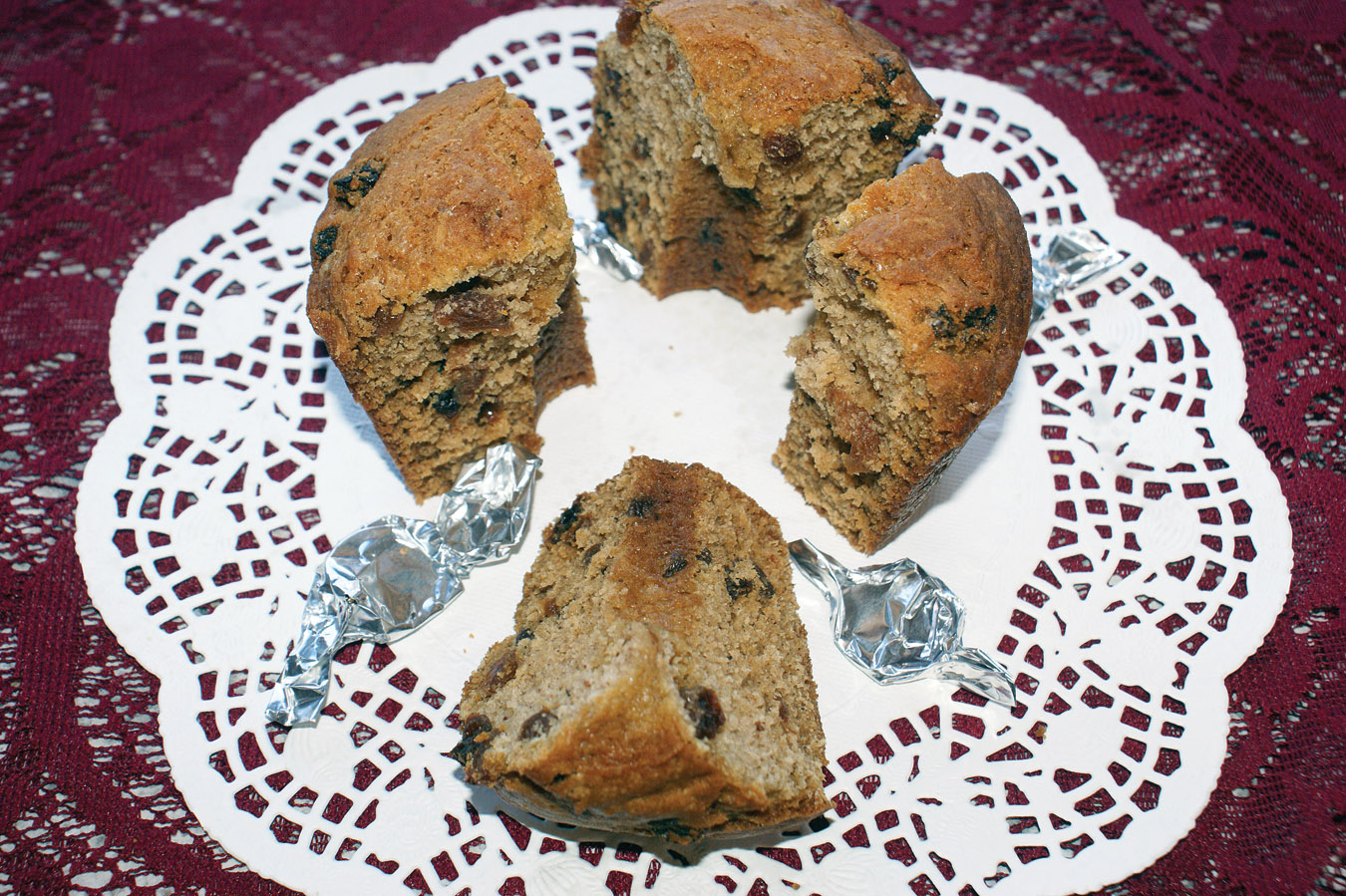
Each little cake serves four, with fortunes hidden in the foil.
Instead of wrapping the tokens in parchment paper and putting them into the batter as grandma did, I simply wrap up the trinkets in foil and place them around the sliced cake, letting each eater pick their own “fortune.” I feel this is safer than accidentally choking on a trinket or biting into a hard coin.
This batter makes a large cake (enough for 12 servings). I often bake it in several small bundt pans instead of one large pan. I serve as much as needed and freeze the rest.
- 2½ cups raisins
- Juice of 1 lemon plus 1 Tbsp. grated zest
- 2 cups hot strong black tea
- 3 cups all-purpose flour
- 1 cup white sugar
- 1 Tbsp. baking soda
- 1 tsp. ground cinnamon
- ¼ tsp. each of ground nutmeg and ground cloves
- ¼ cup melted lard or butter
- 1 beaten egg
- ¼ cup buttermilk (maybe a little more if needed)
Put raisins, lemon juice, and zest into a large bowl, cover with the hot tea, place a plate over the bowl and allow to soak until cool. Drain. Whisk together the dry ingredients, make a well and add the plumped raisins, lard, egg, and buttermilk. Stir until combined, adding a little bit more buttermilk if mixture is too dry. Transfer into six small greased bundt pans or one 10-inch bundt pan. Bake in a 350° F preheated oven for 50 to 60 minutes or until a toothpick inserted into the center comes out clean. Cool slightly before removing from pans.
Homemade corned beef:
Here’s a recipe for corned beef which I have tweaked from Grandma’s old file box. The original recipe was geared for 100 pounds of beef, but I down-sized it to better suit my needs.
- 4 or 5 pound beef brisket (I order mine from my local butcher shop because I do not often find brisket at the supermarket.)
- 2 quarts water
- 1 cup pickling or kosher salt
- ½ tsp. curing salt
- ½ cup brown sugar
- 2 to 3 Tbsp. pickling spice (or do as I do and put in your own desired measures of whole black peppercorns, whole coriander seeds, mustard seeds, a few whole cloves, a piece of cinnamon stick, and 3 or 4 bay leaves.)
- 1 Tbsp. dehydrated garlic
- Generous shake of dried hot chili flakes (optional)
Make a brine by combining water with remaining ingredients (except the meat). Bring the mixture to a boil and simmer for 3 minutes. Remove from heat and refrigerate until cold. Do not put hot brine on the meat.
Place the meat in a glass or earthen container (do not use metal as it may instill an off taste) that will accommodate it to lay flat. Pour the brine over top. Weigh the meat down to keep it submerged. Cover with a lid or plastic wrap and place in the fridge. Leave the meat for at least 7 days to “corn” or cure, flipping it each day to ensure even brining.
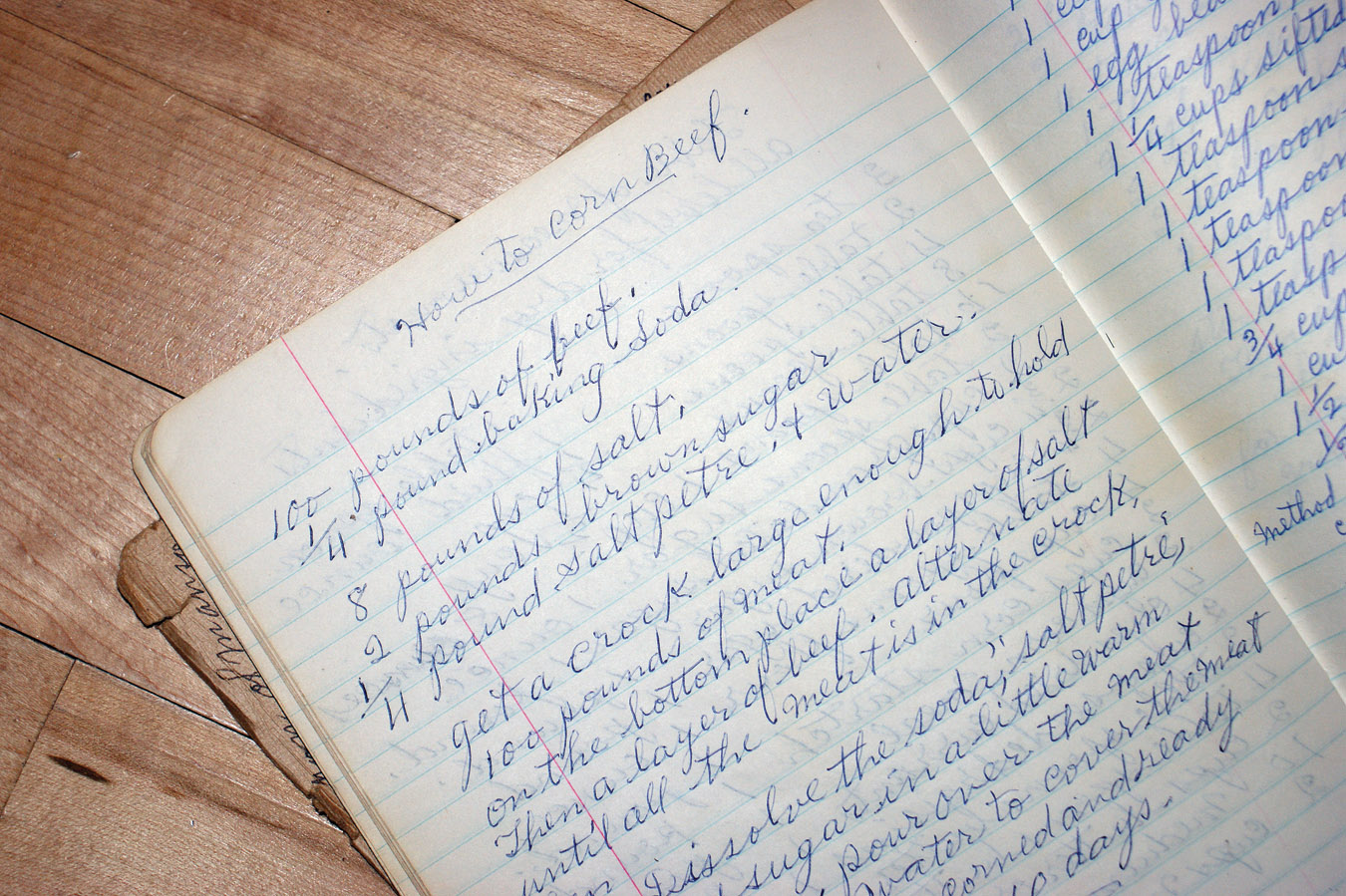
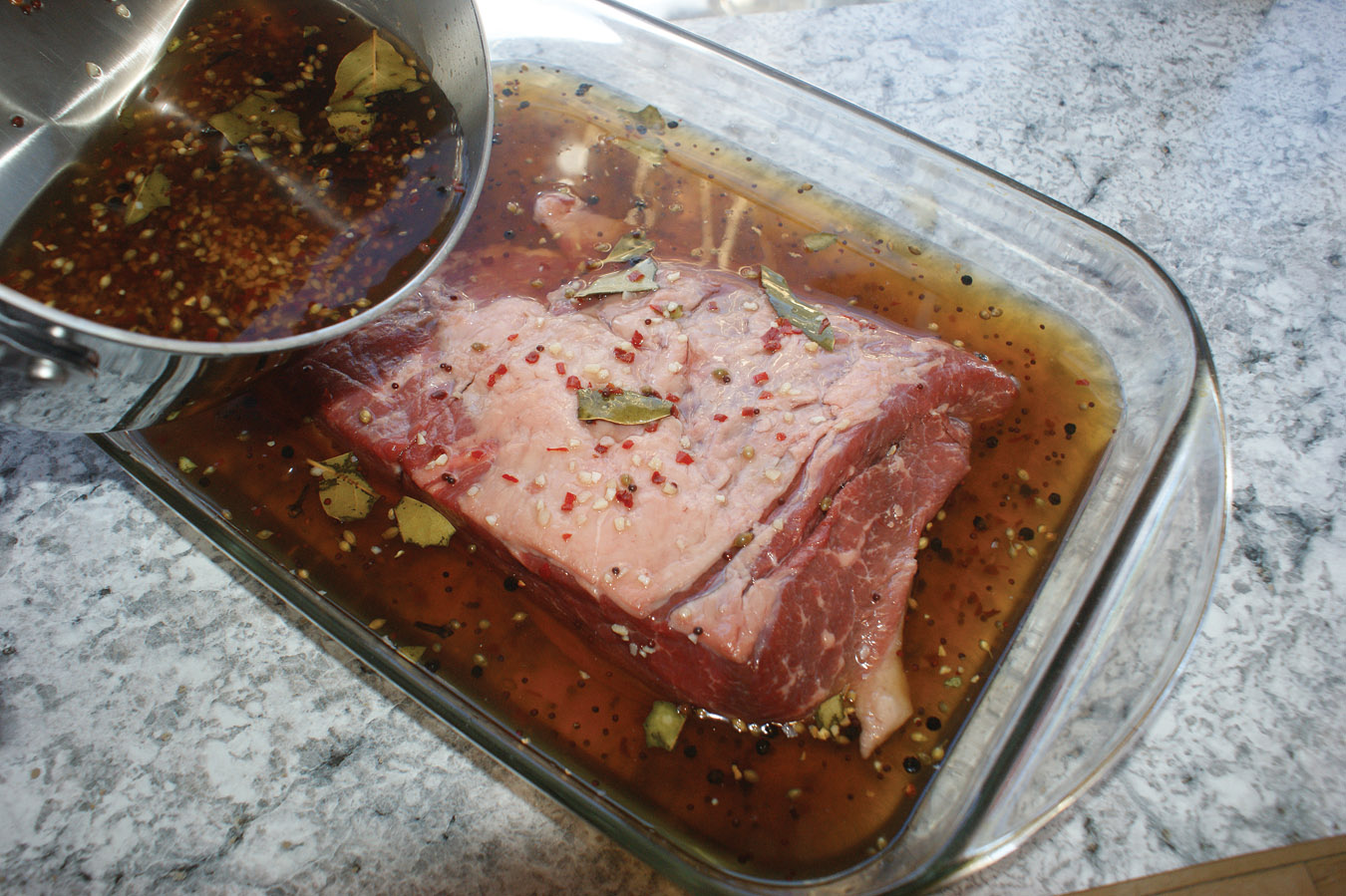
Grandma’s original handwritten recipe for corned beef makes a 100-pound batch. I have adjusted the recipe to make 4-5 pounds at a time.
At the end of the brining time, remove meat from the brine and rinse under cold running water. Discard the brine. Place the brisket in a pot that snuggly fits it and cover with at least one inch of water. Bring to a boil, reduce heat and simmer (over very low stove) for 3 to 4 hours. Meat will be fork tender and will have shrunk by a couple of inches. Remove from the cooking liquid and drain. Cool, wrap, and place in the fridge if not using immediately in a recipe. It will save in the fridge for up to a week or can be vacuum sealed and frozen for longer storage.
A little tip: If you wish to have a rosier color to your corned beef, add 1 cup of beet juice to the brine. It will not affect the flavor but will certainly add some “pinkness” which was obtained in the olden days by using larger amounts of sodium nitrate in the brine. Beet juice is much safer!
Corned beef and cabbage supper with horseradish sauce:
Here’s a traditional recipe for putting your homemade (or store-bought) brisket of corned beef to use. How many does this serve, you ask? Well, that depends on how big a portion of corned beef and how many vegetables you put into the pot. This time around I have used just one pound of my homemade corned beef which, with the vegetables I added, makes four hefty servings, but you can adapt the amounts any way you wish!
-
-
- 1 pound corned beef
- 2 Tbsp. brown sugar
- 2 bay leaves
- Water
- 6 (more or less as needed) whole peeled potatoes
- 6 halved carrots
- 1 small head (or ½ large head) cabbage cut into wedges
- Pepper
-
Sauce:
-
-
- 4 Tbsp. butter
- 3 Tbsp. flour
- 1½ cups of reserved cooking liquid
- 1 Tbsp. honey
- 4 to 5 Tbsp. prepared horseradish
-
Put a previously cooked piece of corned beef into a saucepan. Add the brown sugar and bay leaves. Cover with water and bring to a boil. Add the potatoes, carrots, and cabbage. Season with pepper. Reduce heat, cover and simmer 30 to 40 minutes, or until potatoes are tender and cabbage is soft. Drain, reserving liquid, and holding meat and vegetables hot.
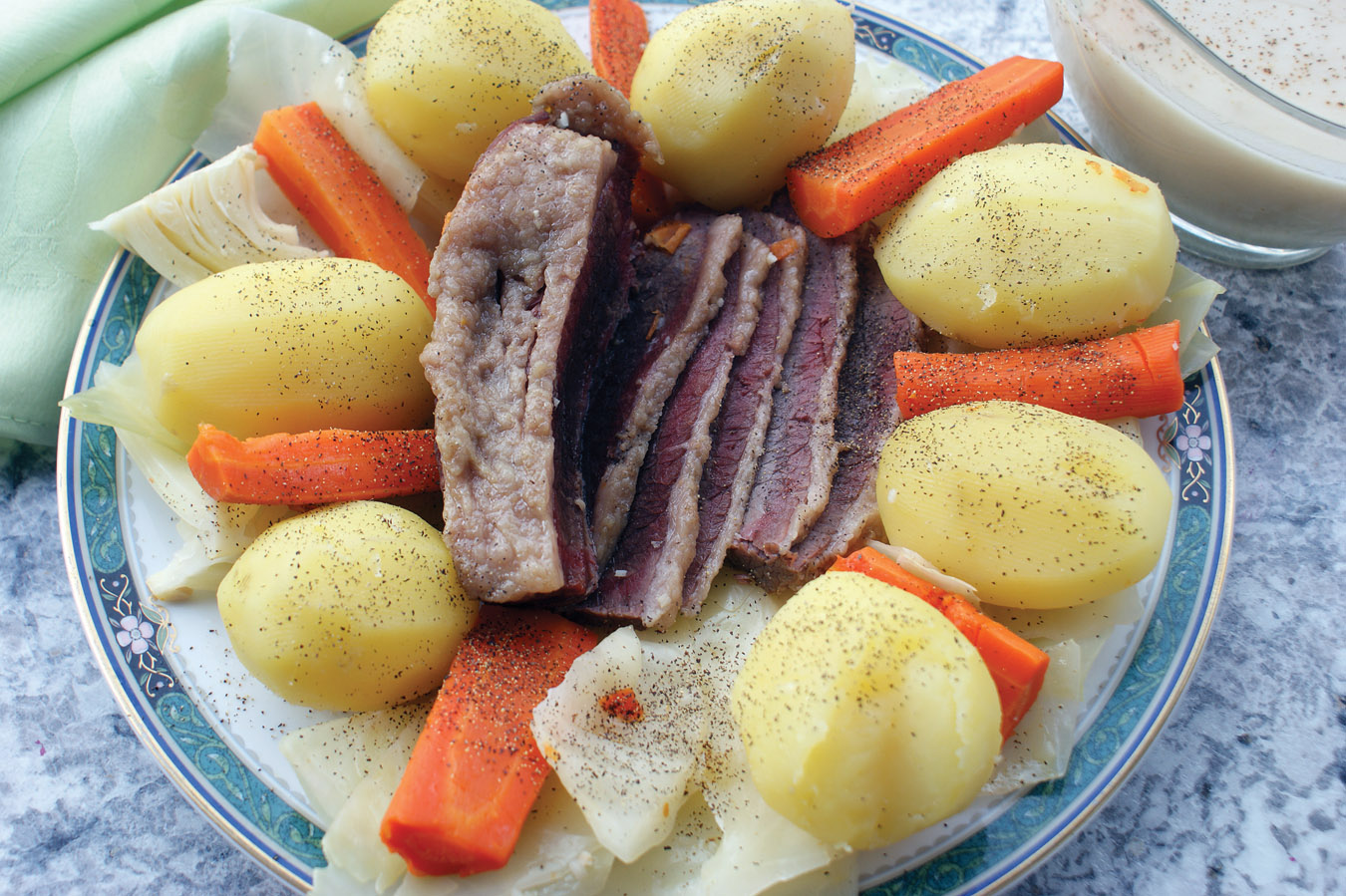
Homemade corned beef
Prepare sauce. Melt butter in a saucepan, stir in the flour and cook until absorbed. Slowly whisk in the reserved hot cooking liquid and cook until smooth. Stir in the honey and horseradish. Cook until thickened.
To serve, slice the corned beef thinly and place on a heated platter. Surround the meat with the cabbage, potatoes, and carrots. Serve the horseradish sauce on the side in a pitcher for drizzling.
Note: The remaining cooking liquid can be saved for soup. Dice up any leftovers from the main meal, return to the broth, and reheat for the next day’s soup.
Corned beef hoagie:
In Grandma’s house, corned beef was sliced very thin and served on thick slabs of homemade rye bread slathered with mustard and topped with homemade sauerkraut from the crock in the cellar. I’ve updated my recipe (to suit my family’s taste) by using soft sesame-topped hoagie buns instead of “black” bread and in place of kraut my gang prefers freshly made coleslaw on their corned beef special.
-
-
- Hoagie buns
- Butter
- Stone ground mustard
- Thin slices of corned beef
- Salt and pepper
- 1 cup grated cabbage
- ½ grated carrot
- ½ minced onion
- ¼ cup of mayonnaise
-
Butter the buns and spread the bottom halves with mustard. Pile on a layer of corned beef and season with salt and pepper. In a small bowl, combine the cabbage, carrot, and onion, blend in the mayonnaise (this makes enough topping for four sandwiches). Pile the coleslaw on the top half of the bun. Sandwich together and devour. On game night, this goes great with a mug of stout for the adults and nutmeg-sprinkled milk for the kids. I don’t know if nutmeg-sprinkled milk is an authentic Irish drink for children or if it was just one of Grandma’s personal creations. In any event, it makes a glass of milk extra special.
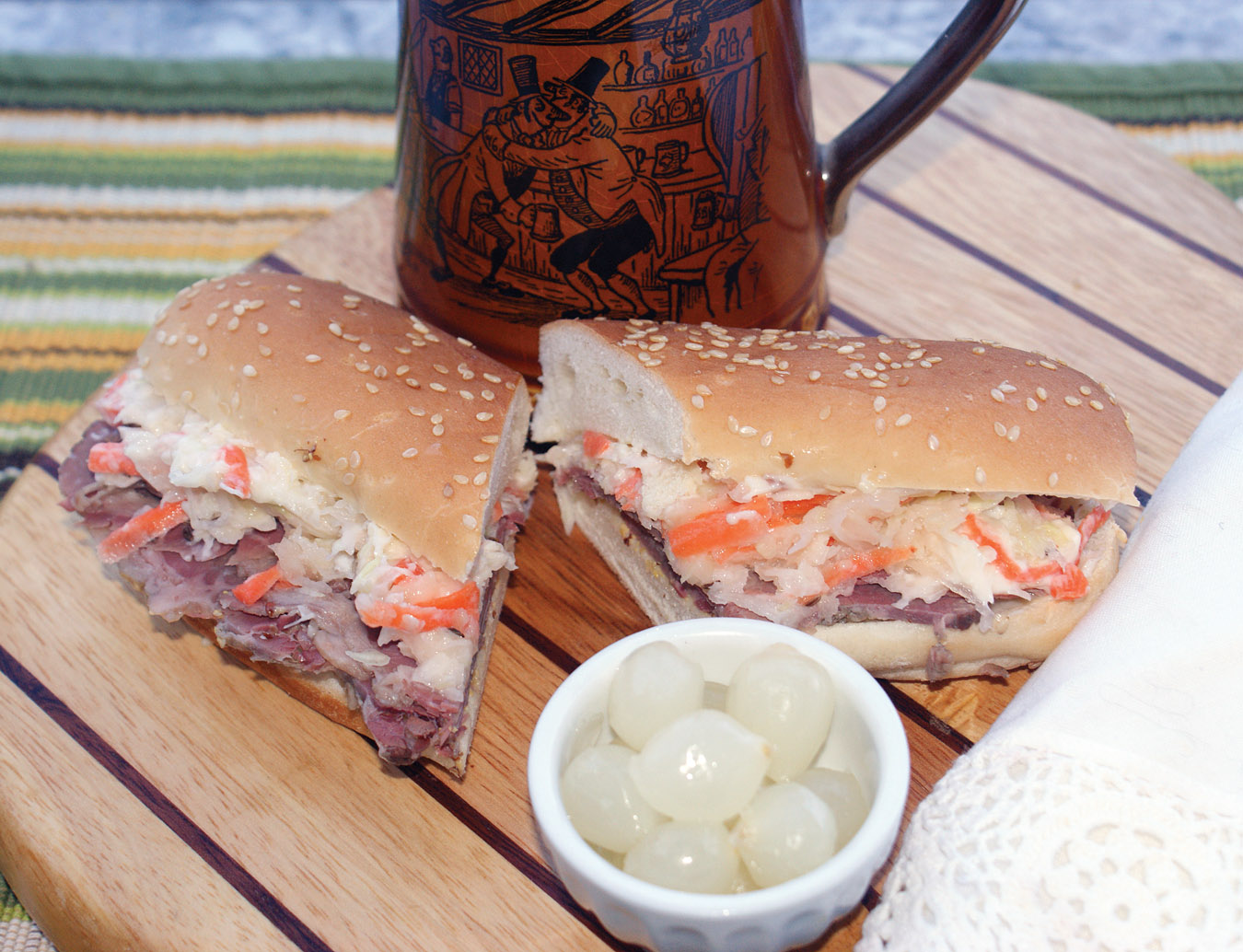
Corned beef hoagie
Gaelic coffee:
I never got to sample this when I was a kid, but at Christmas time, Grandpa and Grandma would toast the season with a goblet of this special coffee which I enjoy today as much as they probably did when I was too young to indulge with them.
-
-
- Irish whiskey
- Brown sugar cubes
- Strong freshly brewed black coffee
- Heavy cream
-
Put 1 or 2 sugar cubes into a heated goblet. Pour a jigger of Irish whiskey over top of the sugar. Fill the glass ¾ full of strong hot black coffee. Stir to dissolve the sugar. Slowly pour a tablespoon or two of heavy cream over the back of a spoon into the coffee. Do not stir it as it is customary to drink the coffee and whisky through the layer of cream. What a marvelous drink for “toasting the good luck of the Irish.”

Gaelic coffee















Your griddle scones are known in the North of Ireland as Soda Farls.
Fresh of the griddle slathered in butter…yum.
Let them cool, split them toast them and fill them with cooked bacon. Food of the gods.